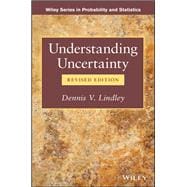"...a reference for everyone who is interested in knowing and handling uncertainty."
—Journal of Applied Statistics
The critically acclaimed First Edition of Understanding Uncertainty provided a study of uncertainty addressed to scholars in all fields, showing that uncertainty could be measured by probability, and that probability obeyed three basic rules that enabled uncertainty to be handled sensibly in everyday life. These ideas were extended to embrace the scientific method and to show how decisions, containing an uncertain element, could be rationally made.
Featuring new material, the Revised Edition remains the go-to guide for uncertainty and decision making, providing further applications at an accessible level including:
- A critical study of transitivity, a basic concept in probability
- A discussion of how the failure of the financial sector to use the proper approach to uncertainty may have contributed to the recent recession
- A consideration of betting, showing that a bookmaker's odds are not expressions of probability
- Applications of the book’s thesis to statistics
- A demonstration that some techniques currently popular in statistics, like significance tests, may be unsound, even seriously misleading, because they violate the rules of probability
Understanding Uncertainty, Revised Edition is ideal for students studying probability or statistics and for anyone interested in one of the most fascinating and vibrant fields of study in contemporary science and mathematics.








